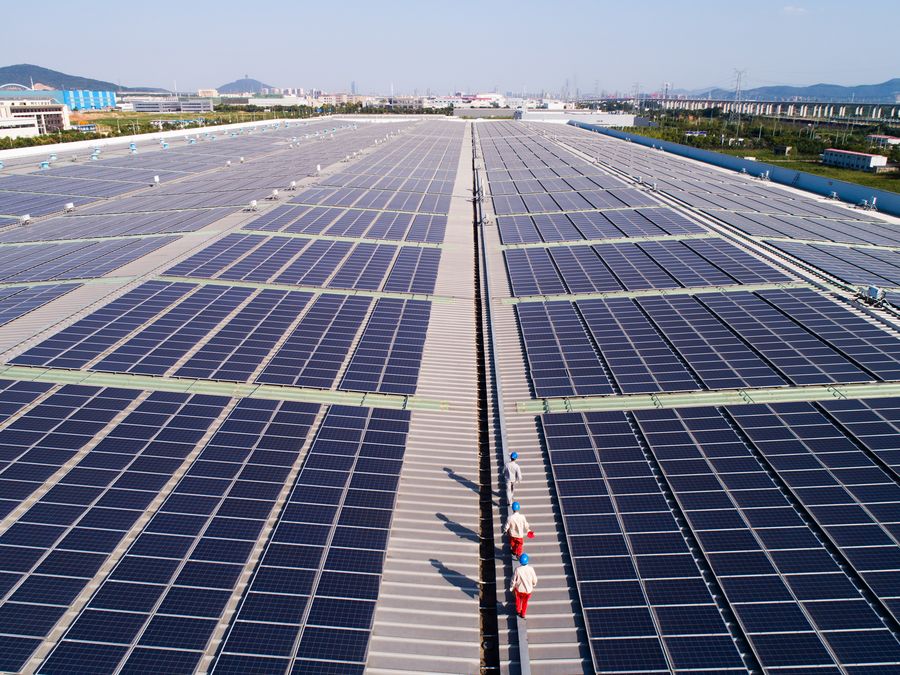
Editor's note: Wang Huiyao is the president of the Center for China and Globalization (CCG). The article reflects the author's opinions and not necessarily the views of CGTN.
Two major international events this week have underscored both the urgency for a rapid transition to clean technologies and the lucrative opportunities this shift will bring to multinational corporations (MNC) that can innovate and collaborate with international partners. They are the fourth China International Import Export (CIIE), which just wrapped up in Shanghai, and the 26th United Nations Climate Change Conference of the Parties (COP26), which is underway in Glasgow.
As the moderator of a parallel session at the fourth Hongqiao International Economic Forum affiliated with the CIIE, I took part in a discussion on the chances and challenges brought by climate change and green development with policymakers, representatives of international organizations, business leaders and scholars in the related fields.
Climate change and green development have become topics of great concern among the international community. A raft of major economies has made commitments on carbon emissions peaking and carbon neutrality in rapid succession.
In September of last year, China announced "dual goals" to peak carbon dioxide emissions by 2030 and achieve carbon neutrality by 2060. In late October of this year, a few days ahead of COP26, the government launched a guideline and action plan to achieve the dual goals.
According to these roadmaps, by 2025, the share of non-fossil fuels in total energy consumption in China will reach around 20 percent. Meanwhile, energy consumption and carbon dioxide emissions per unit of GDP will drop by 13.5 percent and 18 percent, respectively, compared with 2020 levels. These improvements will lay a solid foundation for the road to carbon peak and neutrality.
By 2030, the share of non-fossil energy consumption will reach around 25 percent. Carbon dioxide emissions per unit of gross domestic product (GDP) will have dropped by more than 65 percent compared with the 2005 level, leading to a peaking of carbon dioxide emissions before 2030.
By 2060, the share of non-fossil energy consumption in the national energy mix will be over 80 percent. By this time, China should have achieved carbon neutrality, having fully established a green, low-carbon and circular economy and a clean, low-carbon, safe and efficient energy system.
With action galvanized by national carbon goals, the development of clean energy technologies has been accelerating. Based on a report by Oxford University, Bloomberg Opinion made a conservative estimate that a rapid clean-energy transition would save the world $26 trillion in energy costs compared with continuing today's energy system while contributing toward meeting the Paris targets.

Workers examine solar panels on the rooftop of a local automobile maker in Huzhou, east China's Zhejiang Province, September 19, 2019. /Xinhua
Workers examine solar panels on the rooftop of a local automobile maker in Huzhou, east China's Zhejiang Province, September 19, 2019. /Xinhua
In line with the nation's evolving trade and investment models and industrial upgrading, the Chinese government has announced that it will stop building coal-fired power projects abroad to speed up the phase-out of coal. As a global leader in clean energy technologies, China is keen to deploy and invest in renewable power.
China remains the world's largest producer of wind, solar and hydropower, accounting for 28.7 percent of global wind power production and 28.5 percent of global hydroelectricity, according to 2018 data.
Moving from power to transport, it is expected that electric vehicles (EVs) will dominate the global auto market by the early 2040s. The rise of EVs will have a major disruptive impact on both the auto industry and global oil markets. China continues to be the largest EV market, with a total stock of over 4.5 million vehicles, accounting for nearly half, 44 percent, of EVs worldwide in 2020.
In addition to energy production and consumption, green development will also reshape the way we handle products across their entire life cycle, from design and production to use and end-of-life disposal or recycling. Transforming this whole process requires new business models and forms of collaboration across the industry.
Pressure to reduce carbon emissions and the environmental footprint of products will drive a "greening" of supply chains and encourage MNCs to adopt green technologies and business models, opening new prospects for cooperation.
For example, the rapid growth of the EV industry will generate growing demand for lithium-ion batteries. China's Contemporary Amperex Technology Co., Ltd. (CATL) is currently the world's largest EV battery maker, accounting for about 30 percent of the global market.
CATL cooperates closely with other MNCs such as America's Tesla for new EV production, Japanese automaker Toyota for the development and supply of batteries, and German chemical company BASF for cathode active materials and battery recycling.
Industry will play a major role in achieving our environmental goals. Enterprises are responsible for a large share of carbon emissions, but it is also their innovation and cooperation that will help to develop the technologies that will make the green transition possible. To fully exploit this potential, more can be done to orient firms toward environment, social responsibility and corporate governance (ESG) by enhancing green innovation capacity and developing ESG-oriented financing and accountability mechanisms.
Governments can also act to promote cross-border economic cooperation to boost green trade and investment. For example, the Regional Comprehensive Economic Partnership (RCEP), which takes effect on January 1 next year, will set common and simplified rules of origin used for tariff reductions on trade within the free trade area. A common set of regulations will mean fewer procedures and easier movement of goods.
Also, China's formal application to join the Comprehensive and Progressive Agreement for Trans-Pacific Partnership (CPTPP) indicates the country's determination to align with the higher-standard trade agreement, which includes a chapter on the environment to promote sustainable development through mutually supportive trade and environmental policies.
We have entered the Climate Casino and are rolling the climatic dice, warns William Nordhaus, pioneer of climate economics and winner of the 2018 Nobel Prize for economics. There is still time to turn around and walk back out of the casino. However, this can only be done collectively and with great determination. If we are to avert catastrophe, China, other countries and industry must embrace the green spirit and work together to forge a new pathway to sustainable development.
(If you want to contribute and have specific expertise, please contact us at opinions@cgtn.com.)

